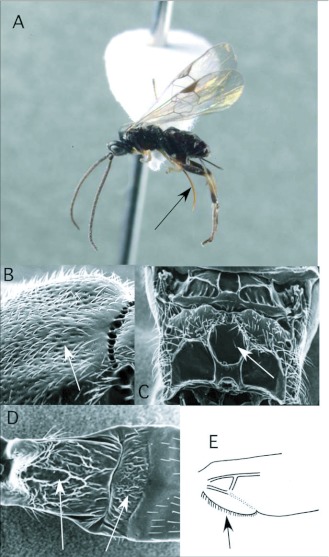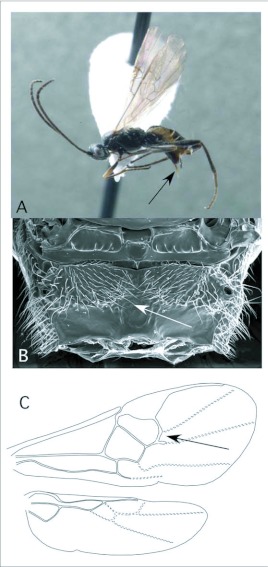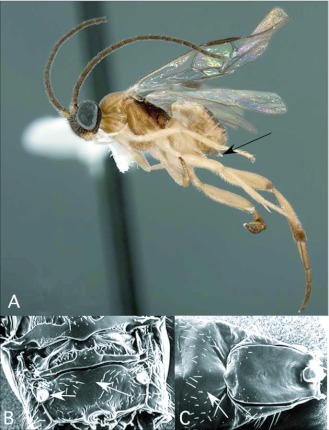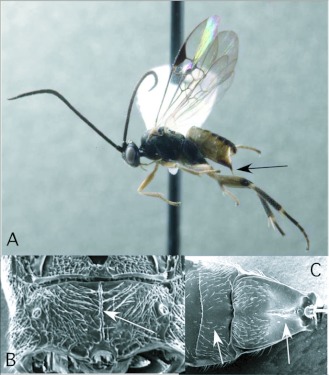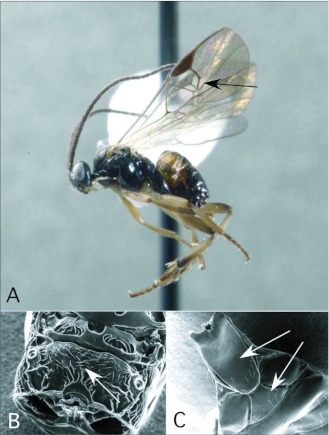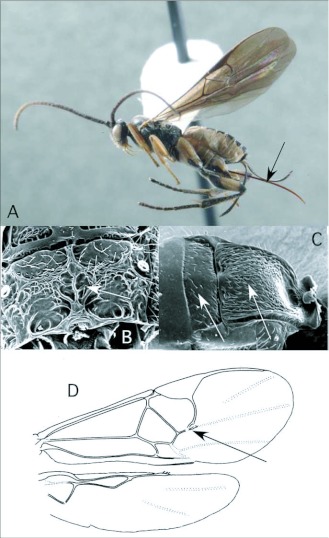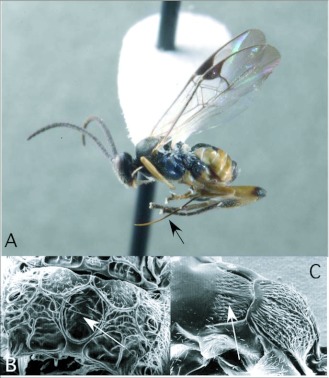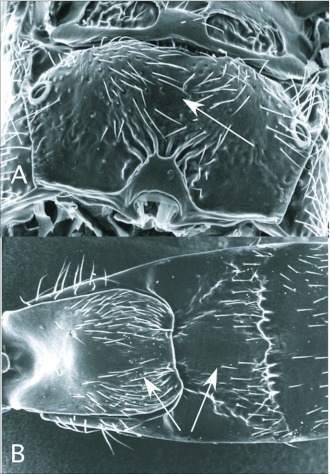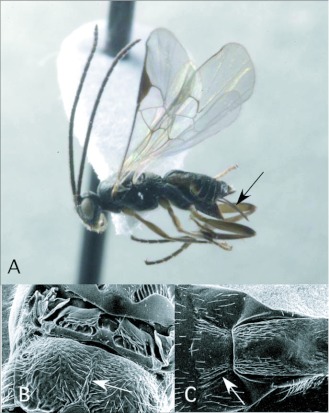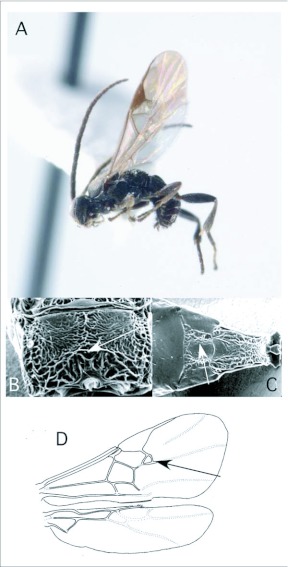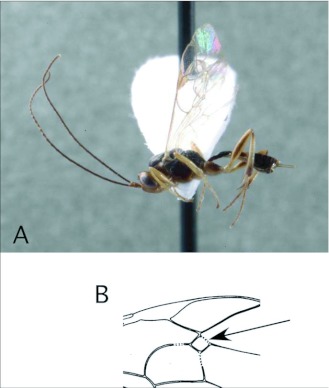Abstract
The microgastrine braconid wasps recovered up through 2007 by the NSF-sponsored rearing project “Caterpillars and Parasitoids of the Eastern Andes in Ecuador” are summarized in terms of their host specialization and faunistic uniqueness. Two hundred fifty eight rearings of caterpillars resulted in records of Microgastrinae, distributed among 14 genera (Apanteles Förster, Choeras Mason, Cotesia Cameron, Diolcogaster Ashmead, Distatrix Mason, Dolichogenidea Viereck, Exix Mason, Glyptapanteles Ashmead, Hypomicrogaster Ashmead, Papanteles Mason, Parapanteles Ashmead, Protapanteles Ashmead, Sathon Mason and Venanus Mason). Eleven records of hyperparasitoids of Microgastrinae are also summarized; Mesochorus Gravenhorst (Ichneumonidae) and Perilampidae are both recorded. The results are compared to those recovered by surveys in other parts of the world, especially by the Janzen-Hallwachs survey of the Area de Conservación Guanacaste (ACG) in Costa Rica. An annotated list of microgastrine genera not yet recorded at Yanayacu, but which we expect to eventually find there based on extrapolation from their known geographic distributions, is provided.
Keywords: parasitoids, Lepidoptera, host ranges
Introduction
Microgastrine braconid wasps are abundant, diverse endoparasitoids of caterpillars throughout essentially all terrestrial habitats on the globe. As a consequence, they have figured strongly in countless ecological and agricultural studies including over 100 pest biological control projects. Cotesia species, for example, have been used in ecological studies of the consequences of metapopulation structure (van Nouhuys and Lei 2004; van Nouhuys 2005), tritrophic interactions (Harvey et al. 2005), the formation of cryptic species (Kankare et al. 2005) and the relationships between mating systems and sex determination mechanisms (de Boer et al. 2007a, b, 2008; Zhou et al. 2006).
Because Microgastrinae disrupt the biology of their host caterpillars in highly specific ways, they have also been used as tools for studying insect nutritional physiology, endocrinology and immunology (summarized in Beckage 1993, 2002; Beckage and Gelman 2004). Mediating these host interactions is a mutualistic relationship with endosymbiotic polydnaviruses, which help to overcome the host's immune system. These viruses have recently generated great interest in terms of functional genomics (Espagne et al. 2004; Kroemer and Webb 2004; Webb and Strand 2004) and evolution (Whitfield 1997b, 2000, 2002, 2003; Whitfield and Asgari 2003; Turnbull and Webb 2002; Espagne et al. 2004; Desjardins et al. 2005; Webb et al. 2006; Stoltz and Whitfield 2009). A strong systematic foundation for this growing wealth of comparative data is highly desirable. Indeed, the wasp/virus biology community already makes heavy predictive use of the limited phylogenetic information available for microgastrines and their relatives (Lapointe et al. 2007, Bezier et al. 2009).
Building a phylogenetic foundation for Microgastrinae has been elusive for several reasons. First, the high species richness of the subfamily (nearly 2,000 described species), especially in tropical regions, has meant that despite significant taxonomic effort on the group, thousands of species remain to be described. Because of their relatively small body size (1.5–4.0mm), microgastrines have, for the most part, been ignored by general entomologists, so that accumulation of new data has tended to center around highly specialized scientific projects. The group's classification was largely developed by a small number of individuals who dedicated many years to their study. The late W. R. M. Mason was the first to develop a phylogeny-based classification for Microgastrinae (Mason 1981) and related subfamilies (Mason 1983; Whitfield and Mason 1994). Although his work has been criticized (Austin 1990; Maetô 1996; Walker et al. 2000; Achterberg 2002), Mason's classifications remain widely used today.
As systematists and field biologists have continued to apply Mason's classification to the wealth of new taxa being discovered, significant problems have arisen, and it has become evident that our understanding of microgastrine phylogeny needs improvement. Several large genera (e. g. Diolocogaster, Glyptapanteles) are either polyphyletic, or at least paraphyletic as currently delineated (Choi and Whitfield in review), and Mason's tribal groupings conflict with more recent phylogenetic results (Walker et al. 1990; Mardulyn and Whitfield 1999; Whitfield et al. 2002; Banks and Whitfield 2006). Several genera have recently been described (Whitfield 1995; Choi and Whitfield 2006), in part to classify species that do not fit well into Mason's (1981) classification. Large scale phylogenetic studies of Microgastrinae based on multiple genes (Banks and Whitfield 2006; Murphy et al. 2008) are currently underway in several laboratories. These promise to set the stage for a more robust classification in the near future.
The neotropical Microgastrinae fauna has, until recently, been especially poorly known, both taxonomically and biologically (Whitfield 1997a). Several small to moderatesized genera have recently been reviewed or revised: Alphomelon (Deans et al. 2003); Austrocotesia (Valerio and Whitfield 2005); Deutenxys (Whitfield and Oltra Moscardo 2004); Diolcogaster and related genera (Choi and Whitfield 2006; Choi in review); Distatrix (Grinter et al. this issue); Exoryza (Valerio et al. 2004); Hypomicrogaster (A. A. Valerio, personal communication); Parapanteles (Valerio et al. 2005b; Valerio and Whitfield 2009); Prasmodon (Valerio et al. 2005a); and Teremys (Valerio and Whitfield 2003).
New species have been described in several of the larger genera - e. g., Apanteks (Whitfield et al. 2001); Glyptapanteles (Whitfield et al. 2002a); Microplitis (Janzen et al. 2003), and Sendaphne (Scatolini and Penteado-Dias 1999) - without full revisions having been attempted. The vast bulk of neotropical microgastrines remain undescribed.
In contrast to the temperate fauna, however, knowledge of the host biology/ecology of neotropical microgastrines is accumulating faster than they can be taxonomically studied, due to systematic rearing surveys of Lepidoptera larvae at several sites. Principal among these surveys are the long-term studies of Janzen and Hallwachs in the Area de Conservación Guanacaste (ACG) in northwest Costa Rica (http://janzen.sas.upenn.edu/caterpillars/database.lasso), the similarly designed survey of Dyer and Gentry at the La Selva Biological Station in Costa Rica (http://www.tulane.edu/%7eldyer/lsacatold/Families.htm), and the more recently initiated study in the eastern Andes of Ecuador led by Dyer, Gentry, Greeney and Walla (http://www.tulane.edu/%7eldyer/lsacat/ecuador/index.htm). For literally hundreds of microgastrine wasp taxa, we now have detailed information about their host caterpillars, caterpillar host plants, and habitat preferences, even before the wasp species have been formally named. Our group has begun an attempt to alleviate this problem by organizing the reared material to make it available for comprehensive systematic study, and by undertaking taxonomic research on particular genera.
In this paper we briefly describe faunistic findings concerning Microgastrinae from the last of these surveys, based at the Yanayacu Biological Station in Napo Province, Ecuador (http://www.yanayacu.org/). The generic composition recovered from Yanayacu, and host preference patterns within the genera, are compared to those known from Costa Rica and elsewhere in the world. For each genus, we provide a habitus photograph and we illustrate diagnostic characters so that the wasps can be readily recognized. We provide an annotated list of genera that might be reasonably be expected to occur with continued sampling in the eastern Andes. We also summarize the hyperparasitoids reared from Microgastrinae in the survey. Formal descriptions of taxa and detailed accounts of species diversity remain to be completed in the future, after the samples have been DNA barcoded and subjected to intense taxonomic study. It is already evident from the ACG microgastrines that accurate rearing data and DNA barcodes are revealing many cryptic, host-specific species that might not have been suspected from mass-collected material (Smith et al. 2008).
Genera of Ecuadorian Microgastrinae recovered to date
After more than 50,000 individual caterpillar rearings, 258 have yielded microgastrine wasps. These are distributed among 14 genera. We summarize findings in each genus below.
Apanteles Förster (Figure 1)
Figure 1.
Apanteles Förster. A: lateral habitus of a female from Yanayacu, showing long ovipositor and sheaths. B-E: diagnostic features of the genus. B: posterior of mesonotum, showing longitudinally confluent punctation. C: propodeum, showing medial areola. D: anterior metasomal tergites, showing medial depression on tergite I and strongly transverse tergite II. E: vannai lobe at base of hindwing, showing flattened and sparsely fringed distal margin (after Whitfield 1997a).
With an estimated 2,000 species, Apanteles Förster, the largest microgastrine genus (Mason 1981), is typically one of the dominant genera reared in caterpillar inventories. Of the 61 reared records of Apanteles from Ecuador, 29 are from pyraloid hosts. The remaining hosts (with number of records in parentheses) are from Geometridae (11), Noctuidae (3), Hesperiidae (2), Arctiidae (2), Choreutidae (1), Saturniidae (1) and yet to be determined families (12). This is consistent with what is known for the North American fauna, where the majority of Apanteles attack many concealed host caterpillar in Pyraloidea, Tortricoidea, Gelechioidea and Tineoidea especially, although exceptions have been reared from Macrolepidoptera (Mason 1981). Apanteles from the ACG survey in Costa Rica have also been reared from a diversity ofsmall concealed hosts. A large percentage of hosts there, however, are hesperiid caterpillars (http://janzen.sas.upenn.edu/caterpillars/database.lasso), which seem to be less common and less diverse at Yanayacu.
Apanteles can be recognized among the New World microgastrines by the following combination of features (see also Figure 1): forewing with second r-m vein absent, so that the small areolet (second submarginal cell) is open distally (as in Figure 3D); hindwing with vannal lobe distally flattened and with reduced fringe of hairs (Figure 1E); punctation of posterior part of mesonotum breaking down into more confluent longitudinal sculpturing, especially submedially (Figure 1B); propodeum with oval, pentagonal, hexagonal or anteriorlyopen medial areola (Figure 1C); first metasomal tergite usually with medial subapical depression (Figure 1D) and second metasomal tergite strongly transverse, often with convex or sinuate posterior margin (Figure 1D); ovipositor and sheaths long and exserted (Figure 1A), manipulatable via a medially desclerotized hypopygium (subgenital plate). The genus is easily confused with the related but less diverse Dolichogenidea, which differs in having distinct punctures posteriorly on the mesonotum, and a convex and evenly fringed hindwing vannai lobe (Figure 6E).
Figure 3.
Cotesia Cameron. A: lateral habitus of a female from Yanayacu, showing short ovipositor and sheaths. B-E: diagnostic features of the genus. B: propodeum, showing medial carina and course background sculpturing. C: anterior metasomal tergites, showing course sculpturing and quadrate form. E: wing venation, showing distally open areolet in forewing (after Whitfield 1997a).
Figure 6.
Dolichogenidea Viereck. A: lateral habitus of a female from Yanayacu, showing long ovipositor and sheaths. B-E: diagnostic features of the genus. B: posterior of mesonotum, showing distinct punctation. C: propodeum, showing medial areola. D: anterior metasomal tergites, showing medial depression on tergite I and strongly transverse tergite II. E: vannai lobe at base of hindwing, showing convex and evenly fringed distal margin (after Whitfield 1997a).
Choeras Mason (Figure 2)
Figure 2.
Choeras Mason. A: lateral habitus of a female from Yanayacu, showing long ovipositor and sheaths. B-D: diagnostic features of the genus. B: anterior metasomal tergites, showing straight lateral margins of tergite I and strongly transverse tergite II. C: propodeum, showing medial carina. D: wing venation, showing distally closed small areolet in forewing (after Whitfield 1997a)
To date, this genus has been reared only once in the Ecuador survey, from a pyralid feeding on Piper (Piperaceae). In general, the genus seems to specialize on Pyraloidea (Mason 1981), but the single host recorded in the ACG survey is in the Thyrididae. Choeras is seldom common, except in more temperate regions of South America (e. g. Argentina).
Choeras is recognizable by the following combination of features (see also Figure 2): forewing with second r-m vein typically present, so that a small, often inconspicuous, areolet is evident (Figure 2D); propodeum with a medial longitudinal carina rather than an areola (Figure 2C); first metasomal tergite typically with rather straight lateral margins, and second tergite strongly transverse (Figure 2B); ovipositor and sheaths long and exserted (Figure 2A), manipulatable via a medially desclerotized hypopygium.
Cotesia Cameron (Figure 3)
This is one of the largest microgastrine genera, with hundreds of species, although it tends to be a more dominant faunal component in temperate regions worldwide. Cotesia species attack exposed larvae from many families of larger moths and butterflies. In the Ecuador survey, they have been recovered 20 times, from Noctuidae, Geometridae and Saturniidae. These are typical hosts elsewhere in the World as well.
Cotesia is recognizable among microgastrines by the following combinations of features (see also Figure 3): forewing with second r-m vein absent, so that the small areolet is open distally (Figure 3D); propodeum coarsely sculptured with medial carina rather than medial areola (Figure 3C); first and second metasomal tergites usually rather quadrate in form and coarsely sculptured (Figure 3B); ovipositor and sheaths short and barely exserted (Figure 3A). The genus is easily confused with the distantly related Parapanteles, which differs in having a medial areola (Figure 11B) that is sometimes superimposed on similar coarse background sculpturing.
Figure 11.
Parapanteles Ashmead. A: lateral habitus of a female from Yanayacu, showing short ovipositor and sheaths. B-D: diagnostic features of the genus. B: propodeum, showing weakly indicated pentagonal medial areola. C: wing venation, showing distally open small areolet in forewing. B & C after Valerio et al. (2005).
Diolcogoster Ashmead (Figure 4)
Figure 4.
Diolcogoster Ashmead. A: lateral habitus of a female from Yanayacu, showing short ovipositor and sheaths. B-D: diagnostic features of the genus. B: propodeum, showing medial areola. C: anterior metasomal tergites, showing medial groove on tergite I. D: wing venation, showing distally closed small areolet in forewing (after Whitfield 1997a).
This genus has only been reared once in the survey, from a pyralid larva. The genus is quite diverse, both in terms of species richness and biology/morphology, especially in lowland tropics worldwide. It is possible that the Yanayacu Station is at too high an elevation (2000+m) for many of the Amazonian Diologaster species. Nevertheless, we expect additional species to be recovered as sampling continues, from a wide variety of hosts, extending beyond Pyraloidea into Noctuoidea, Geometroidea and Papilionoidea. The ACG survey has recovered dozens of Diolcogaster species.
Diolcogaster, highly variable in form and color pattern, is generally recognizable by the following combination of features (see also Figure 4): forewing with second r-m vein present, so that a small areolet is formed (Figure 4D); propodeum with medial carina rather than medial areola (Figure 4B); hind coxa relatively large, extending to or beyond end of third metasomal tergite; first metasomal tergite anteriorly with medial groove (Figure 4C); ovipositor and sheaths short and barely exserted (Figure 4A). The genus is probably not monophyletic, without synonymizing several other small genera within it (Choi and Whitfield in review).
Distatrlx Mason (Figure 5)
Figure 5.
Distatrix Mason. A: lateral habitus of a female from Yanayacu, showing short ovipositor and sheaths (after Grinter et al. this issue). B-C: diagnostic features of the genus. B: propodeum, showing medially smooth, unsculptured surface and enlarged spiracles. C: anterior metasomal tergites, showing weakly margined tergite II.
Distatrix is geographically widespread, but usually uncommon. The genus is typically reared from Geometridae. At least two species occur at Yanayacu. The first is a parasitoid of geometrids, especially Eois, which feeds on Piper spp. (Piperaceae). The second is a gregarious parasitoid of the rare nymphalid butterfly Antirrhea adoptiva porphyrosticta Watkins, which feeds on the cloud forest bamboo Chusquea scandens Kunth (Poaceae) (see Grinter et al. this issue and Greeney et al. this issue). We have two confirmed records of the first species, and one of the second, but expect more as the hosts are intensively surveyed. The ACG survey has recovered several additional species from geometrids and noctuids (see Grinter et al. this issue), consistent with earlier host records from the Nearctic Region (Whitfield and Scaccia 1996; Whitfield et al. 1999).
Distatrix can generally be recognized by the following combination of features (see also Figure 5 as well as Grinter et al. this issue): forewing with second r-m vein absent, so that the small areolet (second submarginal cell) is open distally (as in Figure 3D); propodeum weakly sculptured, sometimes with enlarged spiracles (Figure 5B); first tergite and second metasomal tergites usually rather smooth, the second subtriangular with poorly defined margins posteriorly (Figure 5C); ovipositor and (nearly bare or minutely setose) sheaths short and barely exserted (Figure 5A). The genus could be confused with Glyptapanteles, which differs in that the first metasomal tergite is more strongly narrowed posteriorly, the margins of the second metasomal tergite are better defined, and the ovipositor sheaths exhibit normal setae apically.
Dolichogenidea Viereck (Figure 6)
There are eight records of this genus from Ecuador -- six from pyraloids and two from unknown host families. This is consistent with what is known about Dolichogenidea in other regions, where they typically attack pyraloids, tortricoids, tineoids, gelechioids and other small concealed hosts (Mason 1981). In the ACG survey, this genus has been recorded from Pyralidae and Crambidae, although the majority of hosts are from the Thyrididae, Mimallonidae, and Elachistidae (http://janzen.sas.upenn.edu/caterpillars/database.lasso). Despite their large size, members of these moth families typically feed in concealment.
Dolichogenidea can be recognized among the New World microgastrines by the following combination of features (see also Figure 6): forewing with second r-m vein absent, so that the small areolet is open distally (as in Figure 3D); hindwing with vannai lobe distally convex, bearing an even fringe of hairs (Figure 6E); punctation of posterior part of mesonotum remaining distinct submedially (Figure 6B); propodeum with oval, pentagonal, hexagonal or occasionally poorly defined medial areola (Figure 6C); first metasomal tergite usually broad, with a medial subapical depression (Figure 6D) and second metasomal tergite strongly transverse, often with a convex or sinuate posterior margin (Figure 6D); ovipositor and sheaths long and exserted (Figure 1A), manipulatable via a medially desclerotized hypopygium. The genus is easily confused with the closely related but more diverse Apanteles, which differs in having longitudinal sculpturing posteriorly on the mesonotum (Figure 1B), and a flattened and sparsely fringed hindwing vannal lobe (Figure 1E).
Exix Mason (Figure 7)
Figure 7.
Exix Mason. A: lateral habitus of a female from Yanayacu, showing short ovipositor and sheaths. B-C: diagnostic features of the genus. B: propodeum, showing medial carina. C: anterior metasomal tergites, showing anterior medial groove on tergite I and weakly sculptured roughly rectangular tergite II.
This genus has been reared once by the survey, from a geometrid feeding on Palicourea sp. (Rubiaceae). The only other rearing record for this small New World genus (containing six described species, including two from Ecuador) is from Syngrapha sp. (Noctuidae) in British Columbia (Mason 1981). The ACG survey has not recovered Exix.
Exix can be distingushed by the following combination of features (see also Figure 7): forewing with second r-m vein present, so that a small areolet is formed (as in Figure 4D); propodeum finely sculptured with medial carina rather than medial areola (Figure 7B); first and second metasomal tergites usually rather quadrate in form and either finely sculptured or polished; the first tergite with a longitudinal groove antero-medially (Figure 7C); ovipositor and sheaths short and barely exserted (Figure 7A).
The genus should possibly be synonymized under Diolcogaster, with which it shares a number of features.
Glyptapanteles Ashmead (Figure 8)
Figure 8.
Glyptapanteles Ashmead. A: lateral habitus of a female from Yanayacu, showing distally open areolet in forewing. B-C: diagnostic features of the genus. B: propodeum, showing hint of medial carina and absence of an areola. C: anterior metasomal tergites, showing posteriorly narrowing first tergite and posteriorly broadening second tergite.
This is one of the most diverse microgastrine genera in the neotropics, especially in lowland regions. We have 94 records so far from Ecuador, reared from a variety of Apatelodidae, Arctiidae, Geometridae, Limacodidae, Noctuidae, Nymphalidae, Pieridae, Pyralidae and Saturniidae. The limacodid records are unusual for Glyptapanteles, but otherwise the Ecuadorian host preferences that are typical for the genus elsewhere.
Glyptapanteles can be distinguished from other microgastrine genera by the following combination of features (see also Figure 8): forewing with second r-m vein absent, so that the small areolet is open distally (as in Figure 3D); propodeum coarsely sculptured with medial carina rather than medial areola, or nothing medially (Figure 8B); first metasomal tergite narrowing posteriorly, second metasomal tergite broadening posteriorly and often nearly triangular (Figure 8C); ovipositor and sheaths short and barely exserted. The genus is distinctive, although it could be confused with some Distatrix.
Hypomicrogaster Ashmead (Figure 9)
Figure 9.
Hypomicrogaster Ashmead. A: lateral habitus of a female from Yanayacu, showing long ovipositor and sheaths. B-D: diagnostic features of the genus. B: propodeum, showing oval medial areola bisected by a medial carina. C: anterior metasomal tergites, showing broad tergite I and relatively polished and transverse tergite II. D: wing venation, showing distally closed small areolet in forewing (after Whitfield 1997a).
Hypomicrogaster, another genus with high species richness in the neotropics, also occurs in the Holarctic Region (A. A. Valerio personal communication). In temperate zones, the species are usually recorded as solitary parasitoids almost exclusively emerging from small concealed-feeding caterpillars, including leafminers. It is becoming evident that the host spectrum of Hypomicrogaster is much broader in the neotropics, where it attacks many lepidopteran groups. Neotropical taxa also differ in that they often develop gregariously. Several dozen species of Hypomicrogaster have been recorded from the ACG survey. The Ecuador project has recorded the genus seven times, from a variety of Choreutidae, Lasiocampidae, Noctuidae and Pyralidae.
Hypomicrogaster is relatively variable morphologically, but can be distinguished by the following combination of features (see also Figure 9): forewing with second r-m vein typically present, so that an especially small, often inconspicuous, areolet is evident (Figure 9D); propodeum with a medial longitudinal carina, but usually also with a superimposed areola (Figure 9B); first metasomal tergite typically broad, and second tergite less sculptured and strongly transverse (Figure 9C); ovipositor and sheaths usually long and exserted (Figure 2A), manipulatable via a medially desclerotized hypopygium; a few species possess shorter ovipositors, but otherwise fit the above description.
Papanteles Mason (Figure 10)
Figure 10.
Papantdes Mason. A: lateral habitus of a female from Yanayacu, showing long ovipositor and sheaths. B-C: diagnostic features of the genus. B: propodeum, showing well-formed medial areola. C: anterior metasomal tergites, resembling many male Apanteles in form.
This is a small genus, restricted to the Neotropics (Mason 1981). The two rearings of this genus from Ecuador are from quite different hosts - a choreutid feeding on a fern, and a pyralid feeding on Begonia (Begoniaceae). The few rearings from ACG are from Crambidae (Pyraloidea).
Papanteles resembles Apanteles, but is distinguishable from it, and from microgastrines generally, by the following combination of features (see also Figure 10): forewing with second r-m vein present, so that a small areolet is evident (as in Figure 9D); propodeum with well-defined oval medial areola (Figure 10B); first and second tergites resembling Apanteles but with tergite II less transverse (Figure 10C); ovipositor and sheaths long and exserted (Figure 10A), manipulatable via a medially desclerotized hypopygium. The closed forewing areolet immediately separates this genus from Apanteles and Dolichogenidea.
Parapanteles Ashmead (Figure 11)
Until recently, this mostly New World genus was considered to be small and relatively rare, since it does not appear frequently in Malaise trap samples. In the past, the genus was often confused with Cotesia. In the ACG rearing project, at least two dozen Parapanteles species have now been reared, from a broad taxonomic spectrum of macrolepidopteran hosts. In the Ecuador project, the genus has now been reared 43 times, from a wide variety of hosts, including Apatelodidae, Arctiidae, Geometridae, Noctuidae, Notodontidae, Nymphalidae, Pyralidae and Saturniidae. A revision of Parapanteles has been recently completed (Valerio and Whitfield 2009), but that treatment must be considered provisional in light of the rapid (and continuing) increase in our knowledge of the genus.
Parapanteles has always been a puzzling genus, and though it has frequently been confused with Cotesia, the two are only distantly related (Whitfield et al. 2002). It has the following combination of features (see also Figure 11): forewing with second r-m vein absent, so that the small areolet is open distally (Figure 11 C); propodeum often rather coarsely sculptured (as in Cotesia) but with illformed medial areola rather than medial carina (Figure 11B); metasomal tergites I and II usually rather quadrate in form and coarsely sculptured (as in Cotesia, but sometimes more closely resembling Dolichogenidea); ovipositor and sheaths short and barely exserted (Figure 3A).
Protapanteles Ashmead (Figure 12)
Figure 12.
Protapanteles Ashmead, diagnostic features of the genus. A: propodeum, showing relatively weak sculpturing as in Glyptapanteles. B: anterior metasomal tergites, the shape of the first of which resembles Cotesia, the second Glyptapanteles.
This small genus is most common in the Holarctic region, and its appearance (once) among the Ecuador samples was a surprise. At first we doubted the generic determination, but can now confirm the record. The identity of its host is uncertain. The caterpillar, which fed on Solarium sp. (Solanaceae), did not develop into an adult. Protapanteles is usually reared as a solitary parasitoid from Geometridae (Mason 1981).
Protapanteles is in many respects intermediate morphologically between Cotesia and Glyptapanteles. It shares a quadrate first metasomal tergite (Figure 12B) with Cotesia, and a weakly sculptured propodeum (Figure 12A) and more triangular second metasomal tergite (Figure 12B) with Glyptapanteles. An open forewing areolet and short ovipositor are shared by all three genera.
Sathon Mason (Figure 13)
Figure 13.
Sothon Mason. A: lateral habitus of a female from Yanayacu, showing relatively long ovipositor and sheaths; the hypopygium (subgenital plate) is fully sclerotized medially, unlike most other genera that have long ovipositors. B-C: diagnostic features of the genus. B: propodeum, showing medial carina. C: anterior metasomal tergites, resembling many Glyptapanteles in form.
This relatively small genus was placed by Mason (1981) in his tribe Microgastrini, thus implying a close relationship with Hypomicrogaster among the genera mentioned above. However, subsequent molecular phylogenetic studies have shown that Sathon falls among the lineages related to Glyptapanteles (Whitfield et al. 2002), despite its much longer ovipositor. It will likely be subsumed within the latter genus in future. In the Ecuador project, Sathon has been recovered seven times, from Pyralidae on Urtica sp. (Urticaceae). A taxonomic revision of the genus (Williams 1988), completed before most of these neotropical rearing surveys were conducted, is likely in need of an update.
Sathon generally resembles Glyptapanteles, sharing the open forewing areolet, the finely sculptured propodeum, usually with a medial carina (Figure 13B), and the posteriorly narrowing first metasomal tergite and posteriorly broadening second metasomal tergite (Figure 13C). It differs in having a long ovipositor (Figure 13A). Molecular and morphological phylogenetic studies (Whitfield et al. 2002) suggest that Sathon may be a subclade within Glyptapanteles, implying that it should ultimately become a synonym of the latter.
Venanus Mason (Figure 14)
Figure 14.
Venanus Mason. A: lateral habitus of a male from Yanayacu (females appear similar since they have a short ovipositor). B-D: diagnostic features of the genus. B: propodeum, showing roughly indicated transverse carina bisected by a medial carina. C: anterior metasomal tergites, showing relatively broad tergite I and relatively narrower tergite II. D: wing venation, showing distally closed small areolet in forewing (after Whitfield 1997a).
This relatively small genus is mostly known from the Andes, with rare records of it extending as far north as Canada. Mason (1981) recognized five species of Venanus, but additional species are currently being described by the first author and Claus Rasmussen. Confirmed host records so far are from Pyralidae or microlepidoptera on a wide variety of plants. Venanus has been recovered eight times from the Ecuador project from Pyralidae on Urticaceae, Boraginaceae and Cecropiaceae. One record from an arctiid on Verbesina (Asteraceae) needs confirmation.
The tiny size of Venanus species is relatively distinctive among microgastrines. The genus can be distinguished by the following combination of features: fore wing with second r-m vein present, so that a small to moderate sized areolet is formed (Figure 14D); propodeum with medial carina rather than medial areola, usually crossing a vaguely defined transverse carina in the posterior half (Figure 14B); hind coxa relatively small, barely if at all extending beyond end of metasomal tergite I; metasomal tergite I parallel-sided to broadening posteriorly, and tergite II much narrower and more or less trapezoidal (Figure 14C); ovipositor and sheaths short and barely exserted.
Microgastrine genera not yet recovered, but likely to occur in Ecuador
Several genera will almost certainly be reared from future sampling: Alphomelon Mason (from Hesperiidae Deans et al. 2003); Deuterixys Mason (from Bucculatrix and related microleps - Whitfield and Oltra Moscardo 2004); Microplitis Förster (from Noctuidae and Sphingidae - Janzen et al. 2003); Promicrogaster Brues and Richardson (from hosts feeding on bracket fungi), Pseudapanteles Ashmead (from gelechiid leafminers on Solanaceae, and from Crambidae), Rasivalva Mason (primarily from exposed macrolepidoptera, including Limacodidae) and Rhygoplitis Mason. This last genus is fairly common in Malaise trap samples from eastern Ecuador, and Costa Rica, but for some reason never has appeared in either of the rearing surveys. The hosts appear to be concealed microlepidoptera, including crambids.
Additional microgastrine genera that could potentially be recovered, but are more common in lowland sites, include: Clarkinella Mason, Dasylagon Muesebeck, Fornicia Brulle, Larissimus Nixon, Prasmodon Nixon, Sendaphne Nixon, Snellenius Westwood, Venanides Mason, Wllkinsonellus Mason and Xanthomicrogaster Cameron. Some of these genera are associated with either Crambidae or Limacodidae. The latter family is not well represented at Yanayacu, but becomes more diverse at lower elevations nearby.
Hyperparasitoids of Microgastrinae recovered at Yanayacu Mesochorus Gravenhorst (Figure 15)
Figure 15.
Mesochorus Gravenhorst. A: Lateral habitus of a male from Yanayacu. B: detail of forewing, showing characteristic diamond-shaped areolet (after Wahl 1993).
Mesochorus, a large genus in the family Ichneumonidae, is composed of hyperparasitoids whose hosts include a wide range of microgastrine and other ichneumonoid genera (Dasch 1974). Several Mesochorus have been reared from Microgastrinae hosts, including members of Glyptapanteles and Hypomicrogaster, thus far in the Yanayacu project.. In addition to microgastrine braconids, Mesochorus have been reared from Rogadinae. The host list for Mesochorus from the ACG survey in Costa Rica includes not only Glyptapanteles and Hypomicrogaster, but also Apanteles, Diolcogaster, Cotesia, Microplitis, Parapanteles and Alphomelon. The Costa Rican sampling has been more intensive and has taken place over a longer time period, but the Yanayacu Mesochorus samples nevertheless seem less diverse. This could perhaps be due to the lower population densities of their microgastrine hosts at the Ecuadorian site.
It is beyond the scope of this paper to provide means for separating Mesochorus from all other ichneumonid wasps, but the diamond-shaped forewing areolet (Figure 15B) is diagnostic.
Perilampidae (Perilampus sp.)
One record of a perilampid wasp (Perilampus sp.) from microgastrine cocoons has been recorded so far, but the identity of the host genus is uncertain.
Acknowledgments
This paper would not be possible without the caterpillar rearing efforts of Lee Dyer, Harold Greeney, Tom Walla, Grant Gentry, and the “gusaneros” at the Yanayacu Biological Station - Rafael Granizo, Santiago Hualingua, Marco Hualingua, Maria de los Angeles Simbaña, and Wilmer Rosendo Simbana. The authors thank Chris Grinter for sharing his manuscript on Distatrix before publication, and James Zahniser for assistance with microgastrine digital images. The comments of three anonymous reviewers greatly improved the manuscript. This research has been funded by National Science Foundation collaborative grants DEB 0346729, 0346712, 0346736, 0717173, 0717402, 0717092, 0717034 and 0717458.
Editor's note
Paper copies of this article will be deposited in the following libraries. Senckenberg Library, Frankfurt Germany; National Museum of Natural History, Paris, France; Field Museum of Natural History, Chicago, Illinois USA; the University of Wisconsin, Madison, USA; the University of Arizona, Tucson, Arizona USA; Smithsonian Institution Libraries, Washington D.C. USA; The Linnean Society, London, England.
References
- van Achterberg C. Western Palaearctic genera of the subfamily Microgastrinae: a re-appraisal of the generic and tribal division (Hymenoptera: Braconidae). In: Melika G, Thuroczy C, editors. Parasitic Wasps: Evolution, Systematics, Biodiversity and Biological Control. Agrolnform: 2002. pp. 19–35. [Google Scholar]
- Austin AD. Revision of the enigmatic Australasian genus Miropotes Nixon (Hymenoptera: Braconidae), with comments on the phylogenetic importance of the female ovipositor system. Systematic Entomology. 1990;15:43–68. [Google Scholar]
- Banks JC, Whitfield JB. Dissecting the ancient rapid radiation of microgastrine wasp genera using additional nuclear genes. Molecular Phylogenetics and Evolution. 2006;41:690–703. doi: 10.1016/j.ympev.2006.06.001. [DOI] [PMC free article] [PubMed] [Google Scholar]
- Beckage NE. Games parasites play: the dynamic roles of proteins and peptides in the relationship between parasite and host. In: Beckage NE, Thompson SN, Federici BA, editors. Parasites and Pathogens of Insects, Volume 1: Parasites. Academic Press; 1993. pp. 25–57. [Google Scholar]
- Bezier A, Annaheim M, Herbiniere J, Wetterwald C, Gyapay G, Bernard-Samain S, Wincker P, Roditi I, Heller M, Belghazi M, Pfister-Wilhelm R, Periquet G, Dupuy C, Huguet E, Volkoff A-N, Lanzrein B, Drezen J-M. Polydnaviruses of braconid wasps derive from an ancestral nudivirus. Science. 2009;323:926–930. doi: 10.1126/science.1166788. [DOI] [PubMed] [Google Scholar]
- Beckage NE. Parasite- and pathogen-mediated manipulation of host hormones and behavior. In: Pfaff D, Arnold A, Etgen S, Fahrbach S, Rubin R, editors. Hormones, Brain, and Behavior Volume 3. Academic Press; 2002. pp. 281–315. [Google Scholar]
- Beckage NE, Gelman DB. Wasp parasitoid disruption of host development: Implications for new biologically based strategies for insect control. Annual Review of Entomology. 2004;49:299–330. doi: 10.1146/annurev.ento.49.061802.123324. [DOI] [PubMed] [Google Scholar]
- de Boer J, Ode PJ, Vet LEM, Whitfield JB, Heimpel GE. Complementary sex determination in the parasitoid wasp Cotesia vestalis (= C. plutellae). Journal of Evolutionary Biology. 2007a;20:340–348. doi: 10.1111/j.1420-9101.2006.01193.x. [DOI] [PubMed] [Google Scholar]
- de Boer J, Ode PJ, Vet LEM, Whitfield JB, Heimpel GE. Diploid males sire triploid daughters and sons in the parasitoid wasp Cotesia vestalis. Heredity. 2007b;99:288–294. doi: 10.1038/sj.hdy.6800995. [DOI] [PubMed] [Google Scholar]
- de Boer J, Ode PJ, Vet LEM, Whitfield JB, Rendahl AK, Heimpel GE. Multiple locus complementary sex determination in the parasitoid Cotesia vestalis. Genetics. 2008. [DOI] [PMC free article] [PubMed]
- Choi WY, Whitfield JB. Cuneogaster, a new genus of Microgastrinae (Hymenoptera: Braconidae) from South America. Proceedings of the Entomological Society of Washington. 2006;108:119–124. [Google Scholar]
- Choi WY, Whitfield JB. reviewPhylogenetics of the diolcogastroid complex of Microgastrinae (Hymenoptera: Braconidae: Microgastrinae) based on three genes and morphology. Submitted to Molecular Phylogenetics and Evolution.
- Dasch CE. Neotropic Mesochorinae (Hymenoptera: Ichneumonidae). Memoirs of the American Entomological Institute. 1974;22:1–509. [Google Scholar]
- Deans AR, Whitfield JB, Janzen DH. Taxonomy and natural history of the microgastrine braconid genus Alphomelon. Journal of Hymenoptera Research. 2003;12:1–41. [Google Scholar]
- Desjardins C, Eisen JA, Nene V. New evolutionary frontiers from unusual virus genomes. Genome Biology. 2005;6:1–3. doi: 10.1186/gb-2005-6-3-212. [DOI] [PMC free article] [PubMed] [Google Scholar]
- Espagne E, Dupuy C, Huguet E, Cattolico L, Provost B, Martins N, Poirie M, Periquet G, Drezen JM. Genome sequence of a polydnavirus: insights into symbiotic viral evolution. Science. 2004;306:286–289. doi: 10.1126/science.1103066. [DOI] [PubMed] [Google Scholar]
- Grinter CC, Whitfield JB, Connahs H, Dyer LA, Hallwachs W, Janzen DH. A key to Neotropical Distatrix Mason (Hymenoptera: Braconidae), with descriptions of six new reared species. Journal of Insect Science (this issue) 2008. [DOI] [PMC free article] [PubMed]
- Harvey JA, van Nouhuys S, Biere A. Effects of quantitative variation in allelochemicals in Plantago lanceolata on development of a generalist and specialist herbivore and their endoparasitoids. Journal of Chemical Ecology. 2005;31:287–298. doi: 10.1007/s10886-005-1341-1. [DOI] [PubMed] [Google Scholar]
- Janzen DH, Walker AK, Whitfield JB, Delvare G, Gauld ID. Host-specificity and hyperparasitoids of three new species of Costa Rican Microplitis (Braconidae: Microgastrinae), parasitoids of sphingid caterpillars. Journal of Hymenoptera Research. 2003;12:42–76. [Google Scholar]
- Kankare M, van Nouhuys S, Hanski I. Genetic divergence among host-specific cryptic species in Cotesaia melitaearum aggregate (Hymenoptera: Braconidae), parasitoids of checkerspot butterflies. Annals of the Entomological Society of America. 2005;98:382–394. [Google Scholar]
- Kroemer JA, Webb BA. Polydnavirus genes and genomes: emerging gene families and new insights into polydnavirus replication. Annual Review of Entomology. 2004;49:431–456. doi: 10.1146/annurev.ento.49.072103.120132. [DOI] [PubMed] [Google Scholar]
- Lapointe R, Tanaka K, Barney W, Whitfield J, Banks J, Beliveau C, Stoltz D, Webb B, Cusson M. Genomic and morphological features of a banchine polydnavirus: a comparison with bracoviruses and ichnoviruses. Journal of Virology. 2007;81:6491–6501. doi: 10.1128/JVI.02702-06. [DOI] [PMC free article] [PubMed] [Google Scholar]
- Maetô K. Inter-generic variation in the external male genitalia of the subfamily Microgastrinae (Hymenoptera, Braconidae), with a reassessment of Mason's tribal system. Journal of Hymenoptera Research. 1996;5:38–52. [Google Scholar]
- Mardulyn P, Whitfield JB. Phylogenetic signal in the COI, 16S and 28S genes for inferring relationships among genera of Microgastrinae (Hymenoptera: Braconidae); evidence of a high diversification rate in this group of parasitoids. Molecular Phylogenetics and Evolution. 1999;12:282–294. doi: 10.1006/mpev.1999.0618. [DOI] [PubMed] [Google Scholar]
- Mason WRM. The polyphyletic nature of Apanteles Foerster (Hymenoptera: Braconidae): a phylogeny and reclassification of Microgastrinae. . Memoirs of the Entomological Society of Canada. 1981;115:1–147. [Google Scholar]
- Mason WRM. A new South African subfamily related to Cardiochilinae (Hymenoptera: Braconidae). Contributions of the American Entomological Institute. 1983;20:49–62. [Google Scholar]
- Muesebeck CFW. A revision of the North American ichneumon flies belonging to the subfamilies Neoneurinae and Microgasterinae. Proceedings of the U.S. National Museum. 1922;61:1–76. [Google Scholar]
- Murphy N, Banks JC, Whitfield JB, Austin AD. Phylogeny of the microgastroid complex of subfamilies of braconid parasitoid wasps (Hymenoptera) based on sequence data from seven genes, with an improved estimate of the time of origin of the lineage. Molecular Phylogenetics and Evolution. 2008;47:378–395. doi: 10.1016/j.ympev.2008.01.022. [DOI] [PubMed] [Google Scholar]
- Nixon GEJ. A reclassification of the tribe Microgasterini (Hymenoptera: Braconidae). Bulletin of the British Museum (Natural History), Entomology Supplement. 1965;2:1–284. [Google Scholar]
- van Nouhuys S. Effects of habit fragmentation at different trophic levels in insect communities. Annales Zoologici Fennici. 2005;42:433–447. [Google Scholar]
- van Nouhuys S, Lei G. Parasitoid-host metapopulation dynamics: the causes and consequences of phenological asynchrony. Journal of Animal Ecology. 2004;73:526–535. [Google Scholar]
- Scatolini D, Penteado-Dias AM. A new species of Sendaphne (Hymenoptera, Braconidae, Microgastrinae) from Brazil. Entomological News. 1999;110:53–55. [Google Scholar]
- Smith MA, Rodriguez JJ, Whitfield JB, Deans AR, Janzen DH, Hallwachs W, Hebert PDN. Extreme diversity of tropical parasitoid wasps exposed by interactive integration of natural history, DNA barcoding, morphology and collections. Proceedings of the National Academy of Sciences of the USA (in press) 2008. [DOI] [PMC free article] [PubMed]
- Stoltz DB, Whitfield JB. Making nice with viruses. Science. 2009;323:884–885. doi: 10.1126/science.1169808. [DOI] [PubMed] [Google Scholar]
- Turnbull MW, Webb BA. Perspectives on polydnavirus origin and evolution. Advances in Virus Research. 2002;58:203–254. doi: 10.1016/s0065-3527(02)58006-4. [DOI] [PubMed] [Google Scholar]
- Valeric AA, Deans AR, Whitfield JB. Review of the microgastrine braconid wasp genus Exoryza, with description of a new species, E. monocavus, from Central America. Zootaxa. 2004;526:1–11. [Google Scholar]
- Valeric AA, Rodriguez JJ, Whitfield JB, Janzen DH. Prasmodon zlotnicki, a new Neotropical species of the genus Prasmodon Nixon (Braconidae: Microgastrinae) from Costa Rica, with the first host records from the genus. Zootaxa. 2005;1016:29–38. [Google Scholar]
- Valeric AA, Whitfield JB. A new species of the enigmatic genus Teremys Mason, T. hanniae, from Costa Rica (Hymenoptera: Braconidae). Zootaxa. 2003;364:1–9. [Google Scholar]
- Valeric AA, Whitfield JB. Two new species of the genus Austrocotesia Austin & Dangerfield (Hymenoptera: Braconidae) from the Andean region of South America. Zootaxa. 2005;888:1–11. [Google Scholar]
- Valeric AA, Whitfield JB, Janzen DH. Review of world Parapanteles Ashmead (Hymenoptera: Braconidae: Microgastrinae), with description of fourteen new Neotropical species and the first description of the final instar larvae. Zootaxa. 2009.
- Valerio AA, Whitfield JB, Kole M. Parapanteles rooibos, n. sp. (Hymenoptera: Braconidae: Microgastrinae): the first record of the genus from the African continent. . Zootaxa. 2005;855:1–8. [Google Scholar]
- Wahl DB. In: Family Ichneumonidae. Goulet H, Huber JT, editors. Hymenoptera of the world: an identification guide to families. Agriculture Canada.; 1993. pp. 395–448. [Google Scholar]
- Walker AK, Kitching IJ, Austin AD. A reassessment of the phylogenetic relationships within the Microgastrinae (Hymenoptera: Braconidae). Cladistics. 1990;6:296–306. [Google Scholar]
- Webb BA, Strand MR. The Biology and Genomics of Polydnaviruses. In: Gilbert LI, Iatrou K, Gill SS, editors. Comprehensive Molecular Insect Science. Vol. 6. Elsevier: 2004. pp. 323–360. [Google Scholar]
- Webb BA, Strand MR, Dickey SE, Beck MH, Hilgarth RS, Barney WE, Kadash K, Kroemer JA, Lindstrom KG, Rattanadechakul W, Shelby KS, Thoetkiattikul H, Turnbull MW, Witherell RA. Polydnavirus genomes reflect their dual roles as mutualists and pathogens. Virology. 2006;347:160–174. doi: 10.1016/j.virol.2005.11.010. [DOI] [PubMed] [Google Scholar]
- Whitfield JB. Xanthapanteles, a new genus of Microgastrinae (Hymenoptera: Braconidae) from South America. . Proceedings of the Entomological Society of Washington. 1995;97:879–883. [Google Scholar]
- Whitfield JB. Subfamily Microgastrinae. In: Wharton RA, Marsh PM, Sharkey MJ, editors. Identification Manual to the New World Genera of the Family Braconidae (Hymenoptera) International Society of Hymenopterists Special Publication; 1997a. pp. 333–364. [Google Scholar]
- Whitfield JB. Molecular and morphological data suggest a common origin for the polydnaviruses among braconid wasps. Naturwissenschaften. 1997b;84:502–507. [Google Scholar]
- Whitfield JB. Phylogeny of microgastroid braconid wasps, and what it tells us about polydnavirus evolution The Hymenoptera: Evolution, Biodiversity and Biological Control . In: Austin AD, Dowton M, editors. CSIRO; 2000. pp. 97–105. [Google Scholar]
- Whitfield JB. Estimating the age of the polydnavirus/braconid wasp symbiosis. Proceedings of the National Academy of Sciences of the USA. 2002;99:7508–7513. doi: 10.1073/pnas.112067199. [DOI] [PMC free article] [PubMed] [Google Scholar]
- Whitfield JB. Littlewood TJ, editor. Phylogenetic insights into the evolution of parasitism in Hymenoptera. The Evolution of Parasitism - A Phylogenetic Approach, Advances in Parasitology. 2003. pp. 69–100. [DOI] [PubMed]
- Whitfield JB, Asgari S. Virus or not? - phylogenetics of polydnaviruses and their wasp carriers. Journal of Insect Physiology. 2003;49:397–405. doi: 10.1016/s0022-1910(03)00057-x. [DOI] [PubMed] [Google Scholar]
- Whitfield JB, Benzing A, Ponce F. Review of the Glyptapanteles species (Hymenoptera: Braconidae, Microgastrinae) attacking noctuids in field crops in the Neotropical Region, with descriptions of two new species from the Ecuadorian Andes. Journal of Hymenoptera Research. 2002;11:152–165. [Google Scholar]
- Whitfield JB, Cameron SA, Ramirez SR, Roesch K, Messinger S, Taylor M. Review of the Apanteles species (Hymenoptera: Braconidae) attacking Lepidoptera in Bombus (Fervidobombus) (Hymenoptera: Apidae) colonies in the New World, with description of a new species from tropical South America. . Annals of the Entomological Society of America. 2001;94:851–857. [Google Scholar]
- Whitfield JB, Mardulyn P, Austin AD, Dowton M. Phylogenetic relationships among microgastrine braconid wasp genera based on data from the 16S, COI and 28S genes and morphology. Systematic Entomology. 2002;27:337–359. [Google Scholar]
- Whitfield JB, Marquis RJ, Le Corff J. Host associations of braconid parasitoids (Hymenoptera: Braconidae) reared from Lepidoptera feeding on oaks (Qyercus spp.) in the Missouri Ozarks. Entomological News. 1999;110:225–230. [Google Scholar]
- Whitfield JB, Mason WRM. Mendesellinae, a new subfamily of braconid wasps (Hymenoptera, Braconidae) with a review of relationships within the microgastroid assemblage. Systematic Entomology. 1994;19:61–76. [Google Scholar]
- Whitfield JB, Oltra Moscardo MT. Revision of the neotropical species of Deuterixys Mason (Hymenoptera: Braconidae). . Journal of Hymenoptera Research. 2004;13:134–148. [Google Scholar]
- Whitfield JB, Scaccia B. A new species of Distatrix (Hymenoptera: Braconidae) from California, with biological notes. Proceedings of the Entomological Society of Washington. 1996;98:308–313. [Google Scholar]
- Williams DJM. Classification, phylogeny and zoogeographic studies of species of Sathon Mason (Hymenoptera: Braconidae). . Quaestiones Entomologicae. 1988;24:529–639. [Google Scholar]
- Zhou Y, Gu H, Dorn S. Single-locus sex determination in the parasitoid wasp Cotesia glomerata (Hymenoptera: Braconidae). Heredity. 2006;96:487–492. doi: 10.1038/sj.hdy.6800829. [DOI] [PubMed] [Google Scholar]





